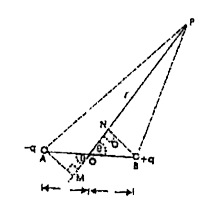What is the direction of electric field at a point on the equitorial line of electric dipole ? Solution in Punjabi
Electric Potential at any point due to an Electric Dipole : Consider an electric dipole AB having charge - 9 at point A and charge + q at point B and 2a is its dipole length. Let O be the centre of the dipole and P be any point at a distance from its centre, where electric potential due to the dipole is to be determined. Let .
The potential at point P due to charge -q,
and the potential at point P due to charge +q,
Therefore, net potential at point P due to the dipole,
or

To find PB and PA, draw BN perpendicular to OP and AM perpendicular to PQ after producing it. From right angled AAMO, we have
In case the length of the dipole is very small as compared to distance r, then
Similarly, it can be obtained that
In the equation (1), substituting for PA and PB, we have
Since q (20) = P, the electric dipole moment of the dipole, the above equation becomes
The equation (2) gives electric potential due to the dipole at a distance r from its centre in a direction making an angle with the dipole.
Special cases : Let us find the electric potential due to the dipole in the following two cases :
When point P lies on the axial line of the dipole :
In such a case, and
Therefore, the equation (2) gives
When point P lies on the equitorial line of the dipole :
In such a case, theta=90^(@)cos90^(@)=0
From equation (2)
y=0
Topper's Solved these Questions
- BOOK - BETTER CHOICE PUBLICATIONCHAPTER - ELECTROSTATIC POTENTIALEXERCISE - NUMERICAL PROBLEMS16videos
ELECTROSTATIC POTENTIAL
- BOOK - BETTER CHOICE PUBLICATIONCHAPTER - ELECTROSTATIC POTENTIALEXERCISE - MOST EXPECTED QUESTIONS7videos
ELECTROSTATIC POTENTIAL
- BOOK - BETTER CHOICE PUBLICATIONCHAPTER - ELECTROSTATIC POTENTIALEXERCISE - SHORT ANSWERTYPE QUESTIONS (2 Marks Questions)9videos
ELECTROSTATIC POTENTIAL
- BOOK - BETTER CHOICE PUBLICATIONCHAPTER - ELECTRONIC DEVICES SOLIDSEXERCISE - Most Expected Questions9videos
ELECTRONIC DEVICES SOLIDS
- BOOK - BETTER CHOICE PUBLICATIONCHAPTER - FORCE ON A CHARGE EXERCISE - NUMERICAL PROBLEMS14videos
FORCE ON A CHARGE
Similar Questions
Two charges 3×10−8Cand−2×10−8C are located 15 cm apart. At what point on the line joining the two charges is the electrical potential zero? Take the potential at infinity to be zero.
04:05View SolutionName the physical quantity whose SI unit is volt metre−1.
08:27View SolutionHow can the whole charge of a conductor be transferred to another isolated conductor?
View SolutionWhy semiconductors are doped?
14:20View SolutionAn electron (with charge 1.6×10−19C) moving at right angles to a uniform magnetic field completes a circular orbit in 10−6sec. Calculate the vlaue of magnetic field. Given mass of electron =9×10−31kg.
53:18View Solutionकिसी विद्युत द्विध्रुव के निरक्षीय रेखा पर स्थित बिंदु पर विद्युत क्षेत्र की दिशा क्या होती है?
View SolutionDerive a relation for electric field of an electric dipole at a point on its equitorial line.
40:43View SolutionThe electric field at a point on equatorial line of a dipole and direction of the dipole moment
01:44View SolutionObtain an expression for electric field intensity at any point on equitorial line of electric dipole. What is the direction of electric field?
02:41View SolutionDipole And Dipole Moment|Electric Field At Axial Point Of Dipole|Electric Field At Equitorial Point Of Dipole|Examples
View SolutionThe electric field at a point on equatorial line of a dipole and direction of the dipole moment
View SolutionElectric Field due to an electric dipole on axial and equitorial points
03:48View SolutionWhat is the angle between the electric dipole moment and the electric field strength due to it on the equitorial line?
03:20View SolutionWhat is the direction of electric field at a point on the equitorial line of electric dipole ?
01:29View SolutionDerive an expression for electric potential at any point due to an electric dipole. Show that the potential at a point on the equitorial line of an electric dipole is zero.
02:11View SolutionWhat is the direction of electric field at a point on the equitorial line of electric dipole?
01:25View Solution

